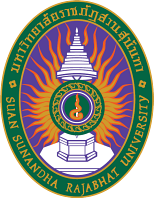Development of the study burnout measurement model of late primary students
Keywords:
measurement, burnout, study burnoutAbstract
The objective of this research was to create and find the quality of the study burnout measurement model of late primary students by using a second-order confirmatory factor analysis. Purposive sampling was used to sample of late primary school the 108 students. The research instrument was of the study burnout measurement model of late primary students, total of 15 items. The result showed the reliability was at 0.911. The statistic data used in analysis is the Confirmatory Factor Analysis (CFA). From the research result, the components of learning burnout of late primary students was 3 components and 9 indicator. Mplus was used to analyze the result of second order confirmatory factor. The result of second-order confirmatory factor analysis showed that the resulted model fitted the empirical data: Chi-Square = 31.417, df = 22, p = .088, CFI = .981, TLI = .969, RMSEA = .308, SRMR = .041 with statistically significant at p = .05. From the mention result, it showed that the 3 components 9 indicates that Able to measure of the study burnout measurement of late primary students.
References
Anawatchakul, R. (2009). Burnout factors influencing academic achievement of Mathayomsuksa 3 students at demonstration school, Ramkhamhaeng University (Master’s thesis). Ramkhamhaeng University, Bangkok. (in Thai)
Balogun, J. A., Hoeberlein-Miller, T. M., Schneider, E., & Katz, J. S. (1996). Academic performance is not a viable determinant of physical therapy students' burnout. Perceptual and Motor Skills, 83(1), 21-22.
Intakaew, A., & Akarapattanawong. (2017). A study of burnout in studying English of undergraduate students of Rajapark institute. Rajapark Journal, 11(24), 135-149. (in Thai)
Maslach, C., & Jackson, S. E. (1981). The measurement of experienced burnout. Journal of Organizational Behavior, 2(2), 99-113.
Maslach, C., & Leiter, M. P. (2005). Stress and burnout: The critical research, In C. L. Cooper (Ed.), Handbook of stress medicine and health (pp. 155-172). Lancaster: CRC Press.
McCarthy, M. E., Pretty, G. M., & Catano, V. (1990). Psychological sense of community and student burnout. Journal of College Student Development, 31(3), 211–216.
Muthen & Muthen. (2020). Retrieved August 31, 2021, from http://www.statmodel.com/
Pongpisanrat, C., & Yurayat, P. (2019). The study of components of learning burnout of college students. Social Sciences Research and Academic Journal, 14(2), 99-110. (in Thai)
Salmela-Aro, K., Kiuru, N., Leskinen, E., & Nurmi, J. E. (2009). School Burnout Inventory (SBI) reliability and validity. European Journal of Psychological Assessment, 25(1), 48-57.
Tang, L., Zhang, F., Yin, R., & Fan, Z. (2021). Effect of interventions on learning burnout: A systematic review and meta-analysis. Frontiers in Psychology, 12, 645662. doi:10.3389/fpsyg.2021.645662
Thambirajah, M. S., Grandison, K. J., & De-Hayes, L. (2008). Understanding school refusal: A handbook for professionals in education, health and social care. London: Jessica Kingsley.
Wang, Y., & Xu, S. (2011). The study on learning burnout of undergraduates and education counter measure. Psychology Research, 4, 36-39.
Wiratchai, N. (1999). Lisrail Model: Analytical Statistics for Research. Third Edition. Bangkok: Chulalongkorn University. (in Thai)
Downloads
Published
How to Cite
Issue
Section
License
บทความที่ได้รับการตีพิมพ์เป็นลิขสิทธิ์ของ สถาบันวิจัยและพัฒนา มหาวิทยาลัยราชภัฎสวนสุนันทา
ข้อความที่ปรากฏในบทความแต่ละเรื่องในวารสารวิชาการเล่มนี้เป็นความคิดเห็นส่วนตัวของผู้เขียนแต่ละท่านไม่เกี่ยวข้องกับมหาวิทยาลัยราชภัฎสวนสุนันทา และคณาจารย์ท่านอื่นๆในมหาวิทยาลัยฯ แต่อย่างใด ความรับผิดชอบองค์ประกอบทั้งหมดของบทความแต่ละเรื่องเป็นของผู้เขียนแต่ละท่าน หากมีความผิดพลาดใดๆ ผู้เขียนแต่ละท่านจะรับผิดชอบบทความของตนเองแต่ผู้เดียว


 ISSN
ISSN 
